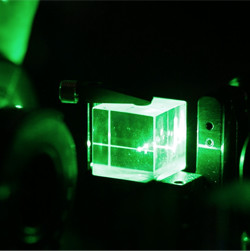 A video of the Canadian prime minister explaining quantum technology's exciting future went viral this year, and now Australian physicists are making that future a present-day reality.
A video of the Canadian prime minister explaining quantum technology's exciting future went viral this year, and now Australian physicists are making that future a present-day reality.
Professor Timothy Ralph from UQ's School of Mathematics and Physics is the Director of the UQ Node of the Centre for Quantum Computation and Communication Technology (CQC2T).
Together with PhD student Josephine Dias and other colleagues, he has announced a discovery that could allow ultra-secure encryption over fibreoptic cables.
The CQC2T was established in 2011 and has recently been awarded $24.7 million in Australian Research Council funding over the next seven years, administered through the University of NSW.
CQC2T is the world's largest team undertaking fundamental research to create a universal quantum computing and communication ecosystem.
Professor Ralph said a "noiseless optical amplifier" was at the heart of the new research.
"When the amplification is good enough, we can split a light beam into several copies, or clones," he said.
"This allows us to clone the light beam with minimal distortion, so that it can still be read with exquisite precision."
Team leader ANU's Professor Ping Koy Lam said one obstacle to sending quantum information was that the quantum state degraded before reaching its destination.
"Our cloner has many possible applications, and could help overcome this problem to achieve secure long-distance communication," he said.
Professor Ralph said the laws of physics – in particular the 'No Cloning Theorem' – prevented high-quality clones being produced with a 100 per cent success rate.
The team used a "probabilistic" method to demonstrate that it is possible to produce clones that exceed theoretical quality limits.
"Imagine Olympic archers being able to choose the shots that land closest to the target's centre to increase their average score," Professor Ralph said.
"By designing our experiment to have probabilistic outputs, we sometimes get lucky and recover more information than is possible using existing deterministic cloning methods.
"We use the results closest to a 'bullseye' and discard the rest."
ANU PhD researcher Jing Yan Haw said the probabilistic method was used in many crypto-communication situations, such as generating secret keys.
"Our probabilistic cloning method generates higher quality quantum clones than have ever been made before, with a success rate of about five per cent," he said.
"We can now create up to five clones of a single quantum state.
"We first encode information onto a light beam. Because this information is in a fragile quantum state, it is difficult to observe or measure."
Professor Lam said quantum cloning opened up important experimental possibilities as well as having applications in ultra-secure long distance quantum networks.
"One of the problems with quantum encryption is its limited communication range," he said.
"We hope this technology could be used to extend the range of communication, and one day lead to impenetrable privacy between two communicating parties."
The research is published in Nature Communications.



